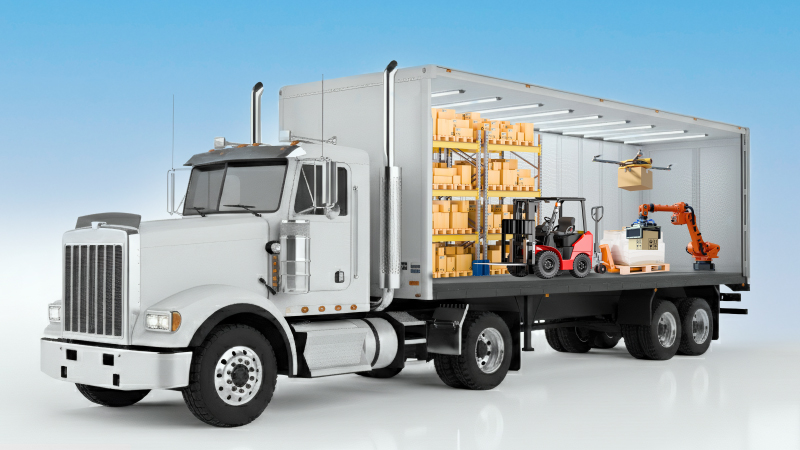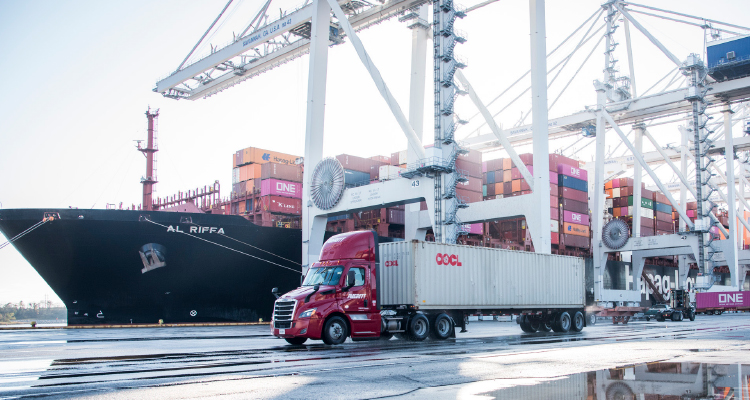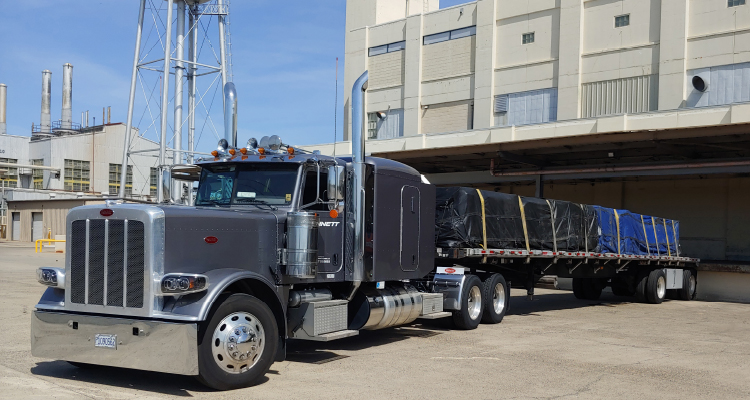Trucking’s Strategic Evolution

Trucking companies continue to transform their businesses, expanding beyond traditional transportation to offer a full spectrum of warehousing and supply chain solutions and navigate a changing marketplace.
When Eric Sauer started at the California Trucking Association (CTA) 24 years ago, most members were traditional trucking companies. In the years since, that model has changed dramatically as more carriers expand their services beyond what they have historically provided, encompassing everything from freight forwarding to inventory management and warehousing.
“Things definitely have changed,” says Sauer, who is chief executive officer of the CTA.
Trucking companies across the country have expanded their services to meet the needs of the marketplace and to create flexibility to better navigate challenging environments for their more traditional services. The recent freight recession and the difficulties that it has created for the truckload sector has shone a fresh spotlight on the potential benefits for trucking companies to commit to different aspects of the supply chain.
A Natural Extension

An Averitt truck at the Port of Savannah, where the company has expanded its services to include drayage and transload for many LTL customers in recent years.
Trucking companies are now more broadly integrated across the entire supply chain. “Truckers have been very good at getting deeper into the supply chain and providing solutions to shippers in a way that’s just a natural extension of what they do,” says Dean Croke, principal analyst at DAT Freight and Analytics, an Oregon-based freight data analytics service and operator of a truckload freight exchange service.
“Over the past three decades, companies have shifted from simply providing services to actively seeking more control over freight and demand,” he says. “They’ve moved their focus from physical assets to solving problems directly.”
Diversification has clearly been a benefit during the ongoing freight recession.
“While the diversification trend doesn’t fix all trucking industry problems, which are mostly about supply and demand, it does help companies cope against tough times in specific market segments,” says Kent Williams, EVP of sales and marketing for Averitt, a Tennessee-based freight transportation and supply chain services provider.
“The past three years in the truckload market perfectly illustrate this: It has been terrible and unsustainable, making it especially difficult for fleets focused solely on over-the-road truckload,” he adds.
Expanded services—whether leaning into already existing services or branching into new ones—has been a critical component of many trucking companies’ strategies in recent years. “Diversifying into new modes or industry segments over the past few years has been extremely helpful for some trucking companies during these challenging times,” Sauer says.
Evolving With the Marketplace
Trucking companies often expand simply to take advantage of emerging opportunities in the marketplace.
For instance, as warehouses moved closer to urban populations as part of the heightened, pandemic-fueled emphasis on next-day and same-day delivery, shorter-haul trucking became much more prevalent among carriers.
Croke notes a shift in freight movement, where companies are now more deeply involved in the supply chain. Large truckload carriers, in particular, have recently expanded beyond just middle-mile transportation to also handle first-mile and, more significantly, final-mile delivery to better control customer shipments.
The expansion of services beyond the traditional transportation model for many carriers in recent years is a result of them being in “survival mode,” Sauer says. Some of that stems from workforce retention, and companies aiming to do what they can to keep drivers on board.
“With the explosion of ecommerce and last-mile demands, many trucking companies have diversified or transitioned into segments of the industry that they may not have been involved with in years,” Sauer says. “That’s partly to meet the demand, but it is also for survival.”
Similarly, many truckload carriers are developing more warehouse capacity.
“During the pandemic, warehouse capacity was hard to find, so many carriers found ways to build warehouse space and provide that service to their customers,” Croke says. “The advantage is, if you control the demand for your trucks through the logistics side of pick and pack and load, you control the utilization levels of your trucks.”
Warehousing has been a particularly important area of expansion for the Bennett Family of Companies, a Georgia-based logistics and transportation provider, says Kris Rzepkowski, vice president of corporate business development. The company has its own warehousing facilities and operates other facilities. The move to warehousing emerged organically from the needs of Bennett’s customers.
“Once carriers build that expertise, with labor and warehouse operational services, they can enter and operate in other environments where those services are needed,” Rzepkowski says.
“For example, some of our bigger customers came through the trucking side, and we talked to them about their other needs,” he says. “The conversations moved straight toward, ‘We have a warehouse issue. We have a supply chain hiccup right here, and we need your team to help us with the best possible way to store, ship, and manage the inventory inside the warehouse.’”
Customers Ask for Help
Over the years, Averitt has gradually formed five vertical business units under its umbrella: LTL, truckload, a dedicated fleet division, a distribution and fulfillment group, and a non-asset group. The distribution and fulfillment group is the youngest of the verticals; it started about five years ago primarily in port cities.
Averitt’s expansion into distribution and fulfillment started in part because “our customers were out of space and asked us for help,” Williams says. Averitt helped those customers and quickly found it to be a successful business model.
“Then in our coastal markets, specifically Savannah and Charleston, many of our LTL customers asked for help with drayage and transload,” Williams says. “That led us to start doing the dray work and later transload work in our coastal facilities.
“We listened to what customers needed,” he adds. “And as we started to get more and more requests, we realized we’ve got something here and need to make this a separate business unit.”
Trucking companies may dabble in a service as a natural outgrowth of their services and the needs of their customers—and then see that service line rapidly gain momentum and become a robust business area. For instance, non-asset-based providers are “all over the place,” according to Rzepkowski, “and that is something that Bennett has grown into as well.
“Our brokerage has grown from a small entity covering overflow requests that our assets couldn’t handle into a quarter-billion-dollar business just servicing customers that need trucks procured and vetted, whether they’re a blend of Bennett trucks and outside trucks, or just outside trucks,” he says.
The Value of Flexibility

Founded in the 1970s as an over-the-road van freight company, the Bennett Family of Companies has often expanded its services based on the changing needs of its customers.
Bennett was founded in the 1970s as an over-the-road van freight company and has evolved perpetually in the years since.
“We keep diversifying because of the cyclical nature of freight,” Rzepkowski says. “Nothing surprises us at this point, whether there’s a downtrend or an uptrend. When freight is down in general, or there’s a freight recession, one of the other industries or trucking modes that we offer usually tends to offset some of that.”
As an example of the dynamic ways that services surface in importance as trends and the marketplace change, is that international freight forwarding has been in demand for Bennett this year “because navigating the tariff world has truly been an adventure and our customers can’t keep up on their own,” Rzepkowski says.
“We bring a niche in international capability that keeps track of all the tariffs and tries to help customers procure the right containers at the right time and use the right mode to keep freight costs at the right level. They find that service helpful,” he adds.
Bennett follows what the federal government is investing in when developing its project-specific efforts. For instance, when the government was committed to green energy, “our wind business exploded, with multiple wind farm installations,” Rzepkowski says.
“When you do a project, it is far more predictive,” he notes. “For example, we know we will tie up x number of trucks in the fleet for the next three or four months, and that provides some regularity to the freight.
“Project-specific efforts also give drivers the ability to find a rhythm and be able to deliver cost savings and cost metrics rather than being wide open on random freight lanes and spot bids,” Rzepkowski says.
“A rocky patch” in one area, such as what truckload has experienced for the past three years, simply means reducing resources there and increasing them elsewhere.
Despite unsustainably low truckload rates over the past three years, Averitt won’t entirely exit that market due to existing customer relationships and contracts, Williams explains. However, the company is not hiring new drivers for the spot market where rates often don’t even cover costs. Instead, it reassigns those drivers to areas with greater need, such as LTL, line haul, or dedicated fleet services, to avoid financial losses.
Better Serving Shippers
As a result of trucking companies’ diversification of services, “we see a more integrated and streamlined process of logistics from start to finish,” Sauer says.
“From a customer standpoint, diversification reduces delays and optimizes the use of these companies that used to probably offer just transportation services,” Sauer says.
Even during marketplace volatility or downturns, Williams says Averitt has kept its focus on the South, Southeast and Southwest regions rather than looking for a geographic expansion—opting to expand its services instead.
“Rather than trying to push our boundaries into other regions or become a national carrier, we had plenty to do in our footprint just by offering our customers additional services,” Williams explains. “It makes Averitt more valuable to our customers than if we were working with them only on one service.”
Ultimately, carriers see their expansion of services as a benefit to their customers and to shippers in general.
“The more different players that shippers have to deal with, the more complicated it can get to pay the bills, hold carriers accountable, and make sure they interoperate with one another to meet their needs; it’s a constant balance,” Rzepkowski says. “Fewer players in the marketplace offering a broader service base benefits shippers.”
For Averitt, providing a wide range of services, such as drayage, transload, truckload, LTL, and dedicated routes, leads to stronger and more enduring partnerships with customers than offering just one service.
The Evolution Continues
The trucking industry has undergone a significant transformation, moving far beyond its traditional role as a simple service provider. Driven by market demands, technological advancements, and the recent freight recession, carriers are diversifying their offerings to include a wide array of supply chain solutions, from warehousing and freight forwarding to final-mile delivery.
This strategic evolution not only enables them to better navigate challenging economic cycles but also fosters deeper, more comprehensive partnerships with shippers, ultimately leading to a more integrated and efficient logistics landscape for all.
Technology Powers Diversification

The strategic evolution of trucking companies into comprehensive supply chain solution providers is heavily reliant on innovative technologies. These digital tools don’t just enhance traditional operations, they actively enable carriers to expand their service portfolios, integrate more deeply into the supply chain, and offer a wider range of value-added services. Here’s how key technologies are driving this diversification:
Fleet Management Software. Beyond simply tracking trucks, modern fleet management software is crucial for optimizing diverse operations. It allows companies to manage a variety of vehicle types and routes (e.g., long-haul, local delivery, dedicated fleets), track varied cargo, and efficiently schedule drivers for different service lines like first- and final-mile delivery or specialized projects. This centralized control is essential for coordinating an expanded service offering.
Warehouse Management Systems (WMS). As trucking companies venture into warehousing and fulfillment, a WMS becomes indispensable. It ensures efficient inventory control, streamlines order picking and packing, and facilitates seamless cross-docking operations. The integration of WMS with transportation management systems allows for a fluid flow of goods from warehouse to truck and vice versa, making the warehousing service a natural, integrated extension of the trucker’s core business.
Data Analytics & AI. The massive amounts of data generated across diversified logistics operations are goldmines for insights. Data analytics and AI tools enable companies to predict demand for various services, optimize pricing strategies across different modes, and identify new service opportunities based on market trends. This intelligence allows for smarter diversification and more agile responses to market shifts, such as determining where new warehousing capacity is most needed or which dedicated routes would be most profitable.
IoT and Telematics. The Internet of Things (IoT) and telematics provide real-time visibility and control across an expanded asset base. Sensors deliver crucial data for cold chain monitoring (vital for perishable goods in warehousing or specialized transport), precise asset tracking (whether a container in a port or a specialized piece of equipment), and predictive maintenance across diversified fleets. This real-time data ensures operational efficiency, reduces downtime, and enhances the reliability of all services offered.
Digital Freight Marketplaces. These platforms extend a trucking company’s reach beyond its owned assets, facilitating broader service offerings. They allow carriers to access a wider network of available loads and to connect with other providers for services they might not directly offer, such as niche freight or capacity for overflow. This flexibility enables them to fulfill diverse customer needs without requiring massive capital investment in every new service segment.
